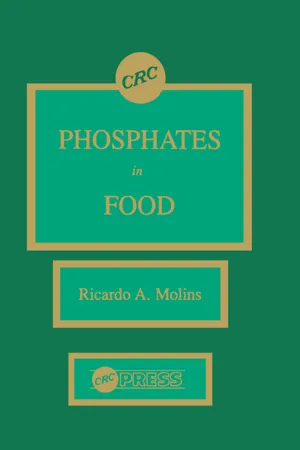![]()
Chapter 1
INTRODUCTION: PHOSPHATES AND PHOSPHOROUS COMPOUNDS IN FOODS
The involvement of phosphorus in the chemistry of all living organisms is no doubt one of the most extensive and complex for any specific element. Although phosphorus constitutes only approximately 1 % of the total weight of the human body (mostly in the form of hydroxyapatite in bones and teeth) compared with 65% for oxygen, 18% for carbon, and 10% for hydrogen, phosphorous compounds intervene in metabolic cycles to an extent that makes them essential for life.1
A “metaphysical speculation” by Van Wazer, one of the most eminent phosphorus chemists, summarized the extreme complexity of the participation of this element in biological processes.2 He said in 1962, “From the little that is known about chemistry in general and particularly that of phosphorous compounds, it would seem reasonable that a biochemistry very different from that of earthlings could be developed in which phosphorous compounds made up the gross fabric of the cells, and that the energy-storing and metabolic processes would involve synthesis and degradation of phosphorus-based macromolecules. If this were the case, it would be expected that such phosphorus-based life forms might exist at lower temperatures than those found on the earth and that an element farther down in the Periodic Table (e.g., Sn or As) would play about the same role in this postulated chemistry as phosphorus does in the carbon-based chemistry of life as we know it.”
There are chemical principles underlying the involvement of phosphates in biological processes. According to Van Wazer, the fact that, “the majority of biochemical reactions take place in aqueous media or at water interfaces”, and, “the exceptional thermodynamical stability of orthophosphates under normal conditions in which redox reactions involving oxygen and carbon take place”, account for much of the importance of phosphorous compounds in biological processes.2 In addition, phosphates react only slowly with water while imparting great solubility to organic compounds otherwise insoluble. Furthermore, phosphates, particularly orthophosphates, form soluble complexes with many cations, something that plays an important role in increasing the bioavailability of those cations.
Phosphorus is heavily involved in energy transfer mechanisms whereby chemical bond energy is transformed into other chemical bonds or into other forms of energy, including kinetic energy in muscle movement, electricity in eels, and light in fireflies.3 In addition to the central role of adenosine triphosphate (ATP) in muscle contraction in live animals, and in the changes that take place before and after the onset of rigor mortis, phosphate-containing nucleotides participate in a myriad metabolic pathways in plants, animals, and microorganisms. Among these, synthesis and breakdown of carbohydrates, proteins (including nucleic acids, hormones, and enzymes), and lipids are nearly all phosphorus-dependent. Although a discussion of most of these aspects of phosphorus metabolism are beyond the scope of this work and can be found in specialized treatises,4 some topics that are relevant to the theme of this text are presented in the appropriate chapters and sections.
Phosphorus is often associated with proteins in biological systems. These “conjugated” proteins include nucleoproteins and phosphoproteins. A third group, the lipoproteins, are normally associated with phospholipids.1 The most important phosphoproteins found in foods are those associated with eggs (phosvitin, vitellin, vitellenin, and ovalbumin) and milk (casein). Of these, casein constitutes approximately 2.7% of bovine milk, whereas ovalbumin, a phosphoglycoprotein, represents over 50% of the protein in eggs. Some important phosphoproteins are involved in iron storage; such are phosvitin in egg yolk, which contains approximately 10% phosphorus and constitutes 80% of the protein phosphorus in egg yolk,5, 6 and ferritin in one marrow and liver.1 Other phosphoproteins are present in body fluids such as blood plasma and in various bodily tissues of animals.
Phosphorus is also found in foods of animal or vegetable origin, associated with lipids in the form of mono- or diesters referred to as phospholipids. Glycerophospholipids are derivatives of glycerophos...
